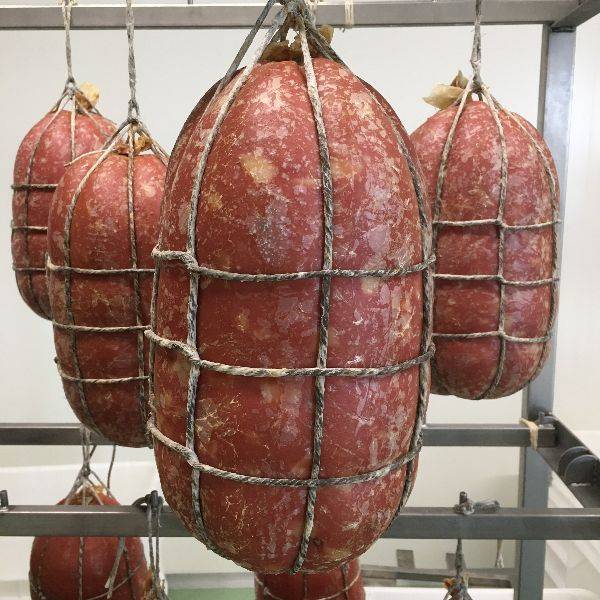In the 16th century. La Mortadella was so prized that it was several times more expensive than prosciutto or ham. The strictly Bolognese art of reducing whole shoulders of pork down into a fine paste was seen as a consummate skill, and those butchers who could do so were artists.

La Mortadella aka La Grassa 'The Fat One'
Aldo Zivieri: Mortadella Master
Raw cuts of meat would have been pounded by hand in mortars (hence one theory of the origin of the name, Mortadella) to a point where they would bind together like glue and, once fed into skins and steamed as sausages, could be sliced extremely thin whilst still holding together. The finest mortadella should almost melt on the tongue; the original texture of the meat entirely dissolved.
Today, we are more likely to look at that pink, seamless paste and bring different associations to it. Finely minced meat products register in our mind as processed meats, where fine texture has become less about luxury as formerly, and more about economy; less about display and more about concealment. Coarse textured products, products where we are still able to derive a visual origin for their raw materials, speak to us in terms of authenticity and transparency. Fine textures today make us suspicious of just what has gone in there.
Such was the success of Bologna, which came to stand for the whole of America in the same way that Mortadella had for Bologna, that the original started to recede from world view. The 30 year ban on importing mortadella into the US, finally lifted in 2000, didn’t help it. And today, although Mortadella's former glory clings on, it does so as a shadow. In the 13th century, over one quarter of the Bolognese city population were employed in the service of this product at roughly 280 salumerie. Now, the true artisans of mortadella number on a single hand.
Zivieri's mortadella tools: notice the progressively smaller dies which dice the meat finer and finer until it is a fine paste.
When Bologna’s most venerable Mortadella butcher, Ennio Pasquini died recently, butcher Aldo Zivieri brought his machinery (Mortadella is, sadly, no longer hand-pounded in pestles). As such, he cast himself as the master’s heir. He shut up his tiny butcher’s shop in the Bolognese Apennines and established his workshop in the city suburbs. And he remembers how, in those first days of opening, he received a visit from a number of salesmen hawking the true ‘mortadella taste’. This taste came out of briefcases, in little vials, and was proof that even within the city and that last bastion of so-called authentic production, disenchantment was at work.
Zivieri makes his mortadella from his autochthonous Mora Romagnola pigs, which graze semi-wild in the forests of the Apennines; and his free range Large Whites. No tripe is added - an authentic ingredient, but one which Zivieri believes overwhelms the fragrance and delicacy of his pork. The pigs are slaughtered in his own abattoir at 16 to 18 months for the Mora and 12 to 14 months fo the Whites (in both cases far above the average slaughter age) only when their fat is fully developed.
He uses the meat from the shoulder, rich in character from its musculature, nerves and tendons, which is progressively diced smaller and smaller (no longer by hand) until it is a fine, fine paste. He will then introduce the traditional golla fat - a hard fat taken from the throat of the pig, and which is mixed into the paste as cubes, to speckle the final pink sausage with traditional white dice. This fat must first be rinsed in hot water to remove a slippery patina which will otherwise prevent the fat from binding with the meat paste: detaching pieces of fat is an unforgivable flaw in a mortadella. He adds fresh garlic, the traditional myrtle berry spice, cumin and coriander. The mixture is then poured into its casing - a pig’s bladder - and steamed to cook. It will then be sold out of Zivieri’s small shop in the Bologna market; and sent to us in Bermondsey. It is striking for its subtlety and absence of the strong Mortadella flavour we’ve come to expect: suggesting to us how much of our expectation today has been fed by those briefcase vials, and found us far from the true flavour of the pig.
Uncooked mortadella paste prior to pouring into casings
Mortadella is most famously eaten sliced - a kind of unholy wafer on the tongue - and ruffled between slices of focaccia. Fine slicing is the way to express its limpid, melting texture, although it can also be eaten in the piece. In Bologna it also has a rich history as an ingredient: in spuma di mortadella, a chilled mousse made with puréed mortadella; or worked together with pork loin, prosciutto, breadcrumbs and parmesan into the meat filling for tortellini. As such, its role is very similar to the one it takes in Zivieri’s Salame Rosa, a rare cooked salame typical to the region.
Salame Rosa: Cooked Bolognase Sausage
Cooked salame is the traditional Bolognese answer to their particular geography, and specifically, the high levels of humidity that make curing challenging. However with the advent of the controlled maturing environments which allow curing to happen wherever - and which have led to a homogenisation of localised, curing practices - the salame rosa has declined. Zivieri tells us how, a century ago, Salame Rosa competed with Mortadella for prominence in the butchers’ windows. Now, outside his shop, it is found only on special occasions if at all. Unlike the fine textured mortadella, here the pork shoulder meat is left coarse in chunks within a finer paste of chuck, leg and mortadella. The result is a sausage with the silkiness of the Mortadella but with textural complexity; the discrete elements of the sausage are visible there in the marbled cut surface. Zivieri emphasises the importance of selecting longer muscles from the shoulder, which are the source of the typical ‘rosa’ colour. Unlike cured salame, and indeed Mortadella, the salame rosa is sliced thick to give its coarse texture more scope to express itself.

